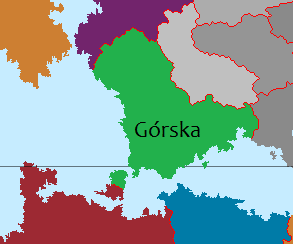Górska
Republic of Górska Górska | |
|---|---|
 | |
| Capital | Ostrołęka |
| Official languages | Górskan language |
| Demonym(s) | Górskan |
| Government | Directorial Republic |
| Area | |
• | 591,430 km2 (228,350 sq mi) |
| Population | |
• 2021 estimate | 43.7 Million |
• Density | 73.9/km2 (191.4/sq mi) |
| GDP (PPP) | estimate |
• Total | $1.650 trillion |
| GDP (nominal) | estimate |
• Total | $844 billion |
| Gini (2021) | 25.5 low |
| HDI (2021) | .885 very high |
| Currency | złoty |
Górska, officially the Republic of Górska, is a country located in south-west Eracura. It is divided into nine Voivodeships across 591,430 square kilometers with a population of 43.7 million citizens. The nation's capital is Ostrołęka, which is also the sixth largest city. Górska is the southernmost nation in Eracura, sharing borders with Svinia and splitting the island of Chryse with Syara.
Górska has been inhabited for thousands of years, with the first recorded tribes being the Gruri in the 2nd Millennia BCE. Beginning in the 1st Millennia BCE the proto-Nordic Bosrei began to settle the interior of the country, while the southern coastlike was settled by Hellenic colonists from the Kydonian League and Ancient Makedon. Roughly half the land was later incorporated into the Makedonian Empire starting in the 3rd Century BCE, leading to centuries of conflict between the Makedonians and the Bosrei. Following the Burning Plague Makedonian influence began to wane and while influence from the Kingdom of Dragovita began to spread, leading to the Slavization of the populace. This process continued after the dissolution of Dragovita and lead to the Górskan language becoming predominant.
Beginning in the 1500s the modern borders of Górska began to form, but settlement of Chryse by ethnic Górskans led to conflict over the island with Syara, first in the 17th Century with the Rioni Union, then twice in the 19th Century with the Kingdom of Makedon and later the Republic of Syara. The latter resulted in the Treaty of Chryse, which officially separated the island into two halves and set the stage for modern Górskan foreign policy centered around Armed neutrality. The modern Górska state emerged in 1818 as a Directorial Republic, a unique system that has been maintained into modern day Tyran. Górska was neutral during the Great War period, which allowed it to escape both the Siduri War and the Eracuran War largely unharmed. Since then, Górska has maintained firmly neutral stance in international affairs, though it is a member of the Organization of Tyrannic Nations.
Górska is a developed market with a mixed-market economy and is considered a middle power. Górska enjoys a high standard of living and economic freedom. The Górskan landscape is highly regarded for its varied and natural beauty, and is a popular tourist destination. Górska's government consists of a nine member executive council and a bicameral legislature, with an upper house consisting of 36 members (four from each Voivodeship) and a lower house of 100 members based on proportional representation.

